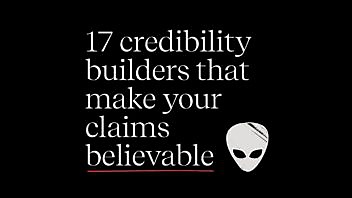Anyone can claim anything they like about their product or service. Claims are empty. Your job as a B2B marketer is to get believed.
But credibility is a funny thing. It’s hard to pin down exactly what makes us believe one person and not another; or believe one claim while remaining suspicious about a very similar claim made by someone else.
To make sure your message is believed, you can’t have too many credibility-builders (though spending too high a proportion of your reader’s attention on credibility issues might backfire by making you appear desperate). In general, more credibility is better.
Let’s look at the top cred-builders:
- Statistics – ideally independently generated
- Awards – the fairy dust of the credibility business
- Accreditations – sometimes essential, other times a hygiene issue
- Analyst attention and endorsement – can go a long way for some customers in some markets
- Media attention and endorsement – the better the source, the more it adds to your cred
- Lists of customers – if you’ve got ’em, flaunt ’em
- Testimonials – more credible than you’d think; the good ones have a ring of truth
- Case studies – often boring and ignored; if you can get them read, they’re worth their weight in gold
- Your resources and assets – just being big and solid and here to stay builds credibility
- The credentials of your team – hard to get this into every conversation, but never hurts
- Other successful products – winners breed winners
- Your company’s commercial success – the trick is to not to focus on the growth but the reasons behind it
Softer signals that indicate credibility:
- Your reputation – the only way to control it is to execute brilliantly in every department
- The way you speak – a straight, open, honest tone of voice does wonders for credibility
- The way you look – clean, inviting design says clear thinking and user-friendliness
- The way you behave – personal interactions can wipe away all of the above or double it
The last credibility builder is probably more important than the first sixteen but is usually undervalued: good, solid logic.
If your argument makes sense and is built on premises that the audience accepts, they will believe you. If it’s built on shaky foundations or makes little leaps of faith, they won’t.
At Velocity, we often break down our clients’ stories into a diagram that shows the steps to a sale — the things people have to believe in order to progress to ‘Yes’. Sometimes the path shows four easy steps separated by simple logic. Other times, it’s seven or eight steps, some separated by yawning chasms — the zones where we’ll have to work extra hard to get prospects to the next step.
The sixteen credibility-builders are all important. But without the seventeenth – a good, strong case – you’re supporting a false front. Spend some time analysing your own steps to a sale. Make sure you’re not asking people to take leaps of faith. Build an argument that earns every step and you’re more than half the way home.

Enjoyed this article?
Take part in the discussion








Comments
There are no comments yet for this post. Why not be the first?